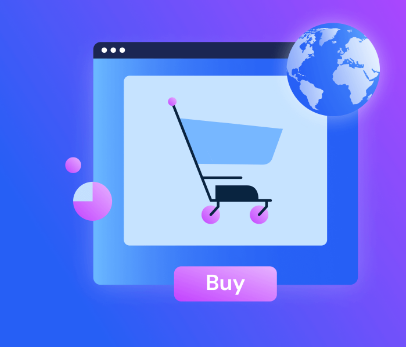To start an e-commerce business, you must get the website design right. Your website is your storefront, so it must be well-designed to attract customers and encourage them to buy. Your website design accounts for 75% of your store’s credibility, and you have less than a second to make a first impression. That means perception is everything, and your customer’s perception is a reality worth considering.
According to a recent industry report, the global e-commerce market is expected to total USD 62415.2 billion by 2030. E-commerce website development is the process of creating the technical aspects of your e-commerce site., including how it works, accepts payments, responds to user actions, and appears aesthetically.

Designing an e-commerce website that is eye-catching and comfortable for visitors takes work. As a Web Design Company, you must consider these views and create a more engaging, helpful, and simple website. This article will discuss the following factors when designing a new e-commerce page.
Top 10 factors to look into when designing a new E-commerce page
1. Mobile responsive
55% of people now shop on mobile devices rather than desktop or laptop computers, so mobile SEO is critical. This makes mobile responsiveness a must-have feature for your e-commerce website. Your website must be accessible from any device, and responsive design should include:
- Text is resized to be easier to read on smaller screens.
- Changeable navigational positioning depending on how the device is held.
- Fewer images to improve load times.
- Enough space around links for thumbs to easily click.
2. Speed
Website speed is critical in e-commerce. Studies show that even a one-second delay in page load time can reduce conversion rates by 7%. Optimize images, use a content delivery network (CDN), and limit HTTP requests to make your website load faster. A fast website improves the customer experience and satisfaction.
3. High-quality photos and videos
Visual content captures users’ attention, keeps them engaged, and influences their purchasing decisions. Using high-quality photos and videos on your website enhances your professional image and the user experience. Studies have shown that product videos increase sales by 85%, making video one of our top e-commerce website features.
4. User Experience
User experience (UX) is one of the most important factors when designing an e-commerce website. Your website should be simple to operate, navigate, and search for products.
Consider how your customers interact with your website and the information they need to make an informed purchase. A well-designed website with a positive user experience can increase conversions and customer satisfaction.
5. How much to sell / how much to invest
Once you’ve decided what products or services to offer online and identified your target audience, you must estimate the purchasing power of your potential customers/visitors. If your web design company is regionally targeted, you can quickly compute this using local data from trade centers or other industry sources. However, it becomes challenging when considering globally or in untraversed territories.

As a result, you should conduct a competitor survey using various eCommerce tools and confidential sources to determine their sales and the amount we should invest in an eCommerce business.
As a result, you can arrange financial resources and register your company according to your investment and future expansion plans. For example, you can register as a partnership, limited liability company, sole proprietor, or corporation.
6. Analytics and Optimization
To ensure that your website is performing optimally, you should monitor and analyze its performance. Tools like Google Analytics can help you identify areas for improvement. Once you’ve identified these areas, you can optimize your website to boost its performance. This could include A/B testing, improving page load times, and redesigning your site.
7. Stay up-to-date with trends
Twenty years ago, e-commerce stores served as intermediary tools for connecting customers with sales teams. Today, e-commerce web design is changing in response to technological advances. Some new trends include interactive layouts, dynamic pages, and data-driven product recommendations.
Customers, unsurprisingly, want a personalized digital user experience. They want an easy way to search for products, buy items, and track orders online.
Social commerce is also growing and has become essential for marketing e-commerce stores and connecting with customers across multiple channels.
8. CMS integration
A content management system (CMS) allows you to store and manage all your visual and written content and marketing documentation in one location. You can change or add information to the website; the changes will be automatically reflected once published. A CMS can also help your employees respond more quickly to customer tickets.
You can use a pre-built solution like OpenCart, PrestaShop, or Magento. These open-source options allow you to incorporate them into your website’s code.
9. Communicating with Your Customers
The ability to connect with your target audience should always be a top priority when developing your website. After all, you’re designing your website for visitors. So, be sure to ask yourself the following questions:
- How can my customers contact me? (Call, email, online chat, etc.)
- What hours do I want to be available to my customers through my preferred communication channels?
- Who in my organization should be able to receive communications from clients?
- What security measures should I take when communicating with customers through my website?
- Am I a good fit for AI or chatbots?
10. Frequently Asked Questions (FAQ) page
A well-thought-out and easily accessible FAQ page can significantly improve your website’s user experience. If a user has a question, a FAQ page can quickly provide an answer. Create a FAQ page as a feature of your e-commerce website.
Conclusion
Designing an e-commerce business entails more than just creating a stunning site. It is about creating a functional, secure, and performance-optimized website.
When a startup or brick-and-mortar store owner thinks of selling online, they must consider each aspect of the business before investing in website development.
By considering these ten factors – speed, mobile responsiveness, security, and analytics user experience- Our web design company New Orleans can create an e-commerce site that increases conversions, attracts customers, and grows your business.


